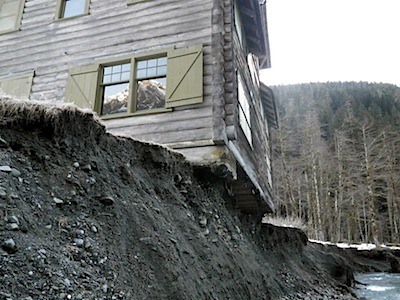National Park Service Awards Contract for Temporary Relocation of the Enchanted Valley Chalet; Relocation will Protect Quinault River
A contract to temporarily relocate the Enchanted Valley Chalet was awarded yesterday to Monroe House Moving, Inc. of Sequim, Washington. The award amount is $124,000. The move is tentatively set to occur during the first two weeks of September, as long as weather, visibility and trail conditions allow. Once all materials and personnel are onsite, moving the building will take about one week to complete.
The contract includes all necessary labor, supervision, equipment and transportation by either foot or pack mule. In addition, the National Park Service will provide helicopter transport for equipment and materials that are too large or heavy to be carried by humans or pack stock. Onsite contract oversight will also be provided by NPS staff.
Using current industry standard house-moving techniques, the contractor will move the Enchanted Valley Chalet a distance of 50 to 100 feet from its current location where it is undercut and in danger of collapsing into the East Fork Quinault River. The threats to natural and wilderness resources posed by the structure collapsing into the river warrant temporary relocation of the building. Additionally, preventing the chalet from imminent collapse will allow time to examine and plan for the long-term future of the structure.
The chalet relocation project was examined in the “Emergency Action to Temporarily Relocate the Enchanted Valley Chalet for the Protection of the East Fork Quinault River Environmental Assessment” (EA) and a Finding of No Significant Impact (FONSI) was issued on July 25.
“Visitor, employee and contractor safety is paramount as we prepare for temporary relocation of the chalet,” said Olympic National Park Superintendent Sarah Creachbaum. “While we will strive to provide day-use and through-hiker access, the Enchanted Valley will be closed for overnight camping for up to two weeks while the project is ongoing,” she explained.
In addition to the camping closure in Enchanted Valley, the Graves Creek Stock Camp will be closed for the duration of the project. Additional details about hiker access to the East Fork Quinault Trail and Enchanted Valley are currently being developed and will be released when available.
The National Park Service is charged with protecting all of Olympic National Park’s priceless resources, from historic structures like the chalet to bull trout, a federally listed threatened species that lives in the East Fork Quinault, to the unique and irreplaceable character of the Olympic Wilderness.
The Enchanted Valley Chalet is located 13 miles from the nearest road, deep within the Olympic Wilderness. The chalet was constructed by Quinault Valley residents in the early 1930s, prior to establishment of Olympic National Park. The chalet served for several decades as a backcountry lodge and more recently, as a wilderness ranger station and emergency shelter. The chalet was added to the National Register of Historic Places in 2007.
Photos shared by park visitors in early January showed that the main channel of the East Fork Quinault River had migrated to within 18 inches of the 1930s-era chalet. Last winter’s storms and high flows resulted in the Quinault’s main channel continuing to shift by at least 15 feet. Recent photographs show that the river has undercut the building by approximately eight feet.
Migration of the East Fork Quinault’s channel is common in the loose, unconsolidated soils of Enchanted Valley. Storms, fallen trees, rockslides and simply the constant process of erosion can all cause the river to shift and carve a new channel.
The EA and the FONSI, along with other supporting documents, are available for review at http://www.parkplanning.nps.gov/EVCEA.



